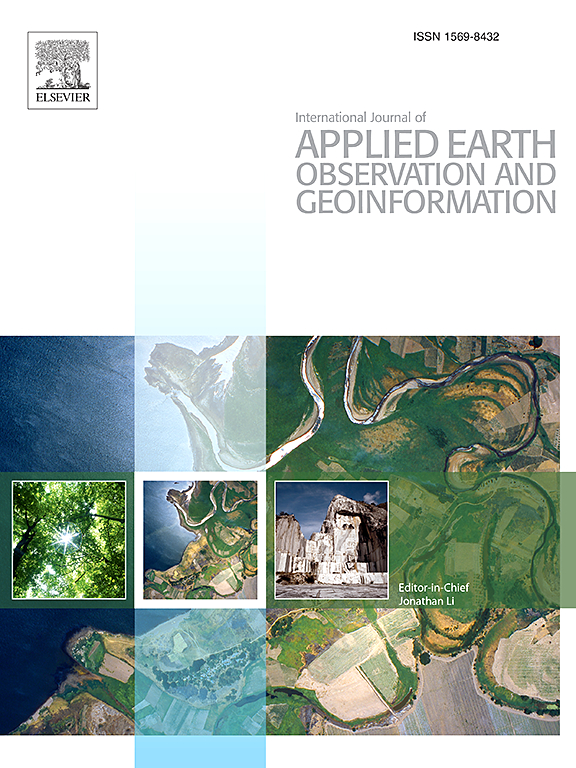Quantifying heat-related risks from urban heat island effects: A global urban expansion perspective
IF 7.6
Q1 REMOTE SENSING
International journal of applied earth observation and geoinformation : ITC journal
Pub Date : 2025-02-01
DOI:10.1016/j.jag.2024.104344
引用次数: 0
Abstract
Quantifying the urban heat island (UHI) effect and its impact on summer heat-related risk is important for both urban environment and human well-being. Existing studies frequently adopt the static (fixed) urban boundary to define urban/rural area in UHI measurement, overlooking the exacerbation of the urbanization-induced warming during long-term urban expansion and the consequent increase in urban heat risks. Here we measured the global surface UHI (SUHI) intensity up to 7,554 urban patches during 2000–2015 using every five-year dynamic urban boundary, followed by a two-stage analysis based on a Distributed Lag Non-linear Model (DLNM) to quantify the additional heat-related risks caused by the urbanization-induced warming. Our results show that the global average SUHI intensity increased by approximately 10 % in 15 years with distinct seasonal and diurnal variations. The global urban expansion from 2000 to 2015 resulted in an average increase of 0.61℃ (95 % CI = 0.56℃-0.66℃) in summer UHI intensity for newly built-up areas. This urbanization-induced warming further leads to a 20 % (95 % CI = 14.8 %-25.2 %) increase in summer heat relative risk (RR) on average, which implied an average increase of 20 % (95 % CI = 14.8 %-25.2 %) in annual heat-related mortality for the newly built-up areas. Furthermore, over 2.3 % of the world population would experience an RR increase greater than 10 %. This study highlights the importance of dynamic urban boundary for long-time span UHI measurements, providing a deeper understanding of the role of urbanization-induced warming on urban heat risk.
从城市热岛效应量化热相关风险:全球城市扩张视角
量化城市热岛效应及其对夏季热相关风险的影响对城市环境和人类福祉都具有重要意义。现有研究在城市热岛指数测量中经常采用静态(固定)城市边界来定义城市/农村地区,忽视了长期城市扩张过程中城市化引起的变暖加剧及其导致的城市热风险增加。本研究利用每5年动态城市边界测量2000-2015年间全球地表热岛强度达7554个城市斑块,然后基于分布式滞后非线性模型(DLNM)进行两阶段分析,量化城市化引起的增暖带来的额外热相关风险。结果表明,全球平均SUHI强度在15年内增加了约10%,具有明显的季节和日变化。2000 - 2015年全球城市扩张导致新建建成区夏季热岛强度平均升高0.61℃(95% CI = 0.56℃~ 0.66℃)。这种城市化引起的变暖进一步导致夏季热相对危险度(RR)平均增加20% (95% CI = 14.8% - 25.2%),这意味着新建成区的年热相关死亡率平均增加20% (95% CI = 14.8% - 25.2%)。此外,超过2.3%的世界人口将经历超过10%的RR增长。该研究强调了动态城市边界对长跨度热岛指数测量的重要性,为深入了解城市化引起的变暖对城市热风险的作用提供了依据。
本文章由计算机程序翻译,如有差异,请以英文原文为准。
求助全文
约1分钟内获得全文
求助全文
来源期刊

International journal of applied earth observation and geoinformation : ITC journal
Global and Planetary Change, Management, Monitoring, Policy and Law, Earth-Surface Processes, Computers in Earth Sciences
CiteScore
12.00
自引率
0.00%
发文量
0
审稿时长
77 days
期刊介绍:
The International Journal of Applied Earth Observation and Geoinformation publishes original papers that utilize earth observation data for natural resource and environmental inventory and management. These data primarily originate from remote sensing platforms, including satellites and aircraft, supplemented by surface and subsurface measurements. Addressing natural resources such as forests, agricultural land, soils, and water, as well as environmental concerns like biodiversity, land degradation, and hazards, the journal explores conceptual and data-driven approaches. It covers geoinformation themes like capturing, databasing, visualization, interpretation, data quality, and spatial uncertainty.
 求助内容:
求助内容: 应助结果提醒方式:
应助结果提醒方式:


